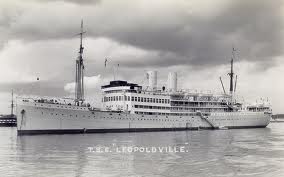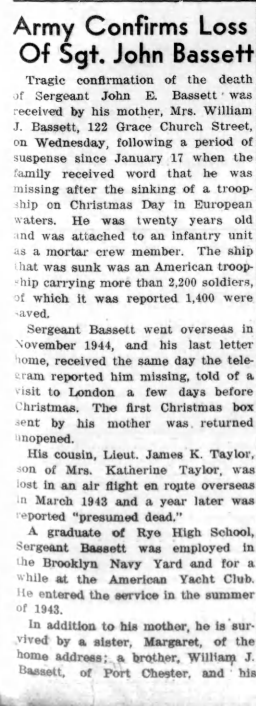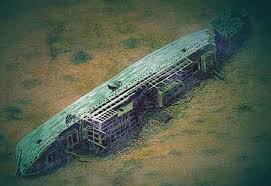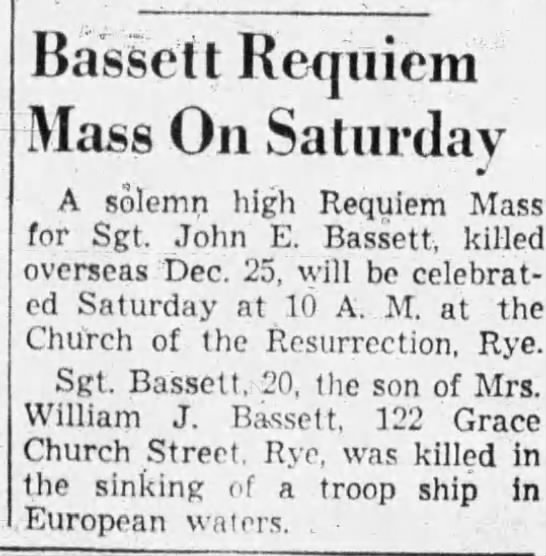John E. Bassett was born August 23,1924 to William J. and Mary E. Bassett. He had a sister Margaret and a brother William. His father was a vacuum cleaner salesman and his mother was a public school teacher. His brother was a newspaper reporter and his sister was a typist/secretary for the probation department of childrens court and they all lived at 122 Grace Church Street. John participated in Boy Scouts and was a member of the YMCA. A graduate of Resurrection Parochial School and Rye High School, Sergeant Bassett was employed at the Brooklyn Navy Yard before entering the Army.
Service Time: John enlisted in the U. S. Army on February 19, 1943 and after basic training was assigned to the 262nd Regiment of the 66th Infantry Division. He achieved the rank of Sergeant. Sergeant Bassett went overseas in November 1944, and his last letter home told of a visit to London a few days before Christmas. The first Christmas box sent by his mother was returned unopened.
On Christmas Eve, 1944, the Belgian troopship SS Leopoldville was transporting Johns unit from Southampton, England to Cherbourg, France on the way to relieve the troops at the battle of the Bulge. Within five and a half miles from shore, the Leopoldville was struck by a torpedo fired by the German submarine U-486. Oberleutnant Gerhard Meyer and his crew in U-486 had launched the boat on the 12th of February earlier that year, and had sailed from Kiel for Norway on the 6th of November 1944 to go on patrol via Bergen, then sailed west around Ireland. Now they lay in wait for Allied shipping off Cherbourg. They had recently tasted success by accounting for their first victim, the British Silver Laurel, now they waited patiently for the next victim to enter their web. Within five and a half miles from shore, the Leopoldville was struck by a torpedo fired by the German submarine U-486. Oberleutnant Gerhard Meyer and his crew in U-486 had launched the boat on the 12th of February earlier that year, and had sailed from Kiel for Norway on the 6th of November 1944 to go on patrol via Bergen, then sailed west around Ireland. Now they lay in wait for Allied shipping off Cherbourg. They had recently tasted success by accounting for their first victim, the British Silver Laurel, now they waited patiently for the next victim to enter their web.
 Leopoldville obliged by coming into range about 1754 (5.54 PM) when a torpedo was fired. Meyer took the boat deep to await the inevitable depth charge attack. His torpedo ran truly, smacking into number 4 hold on the starboard side of the troopship. Compartments E4, F4, and G4 all flooded, with the access ladders to the upper decks in general destroyed. Leopoldville obliged by coming into range about 1754 (5.54 PM) when a torpedo was fired. Meyer took the boat deep to await the inevitable depth charge attack. His torpedo ran truly, smacking into number 4 hold on the starboard side of the troopship. Compartments E4, F4, and G4 all flooded, with the access ladders to the upper decks in general destroyed.
The torpedo hit the compartment where John Bassett's Co. F, 262nd Regiment was quartered. Only 19 of the 175 Co. F soldiers survived. Of the 300 troops in these areas, only a few managed to make it to the safety of higher decks and Two and a half hours later, the ship sank.
 The very fact that it was Christmas Eve, on that day and at that time, compounded the problem. Ashore it was holiday mood, hundreds of small craft tied up in the harbor could have quickly gone to Leopoldville's aid, but crews were minimal, the crafts' engines cold, shore base staff also at minimum levels, all off to holiday parties, in a let-us-forget-the-war mode, totally switched off. The very fact that it was Christmas Eve, on that day and at that time, compounded the problem. Ashore it was holiday mood, hundreds of small craft tied up in the harbor could have quickly gone to Leopoldville's aid, but crews were minimal, the crafts' engines cold, shore base staff also at minimum levels, all off to holiday parties, in a let-us-forget-the-war mode, totally switched off.
The American troopship was carrying more than 2,200 soldiers, of which it was reported 1,400 were saved.
The SS Leopoldville sinking produced the second largest loss of life from a troopship disaster in the entire European war. The toll: 14 officers, including two battalion commanders, and 784 enlisted men dead or missing. Many of those killed were only 18 to 21 years old and 493 bodies were never recovered. John was one of those who was lost at sea and he and his Regiment are memorialized at the American Cemetery in Collevile-sur-Mer, France.
In general, both the British and the United States authorities did not see fit to release the true details about the sinking of Leopoldville. It took until 1958-59 for U.S. military documents about this disaster to be declassified. In 1984 Clive Cussler with his  shipwreck organisation, the National Underwater and Marine Agency (NUMA), found the ship at 49 degrees 44. 01 minutes N and 01 degrees 36.40 minutes E, different from where the wreck had been previously marked on charts. In 1996 the British released some of their documents on this incident, but not all. Two books, A Night Before Christmas, by Jacquin Sanders, Buccaneer Books Inc., New York, 1993, and SS Leopoldville Disaster, by Allan Anrade, Tern Book Company, New York, 1997, have helped lift the veil on this tragic story of the sea in World War II. shipwreck organisation, the National Underwater and Marine Agency (NUMA), found the ship at 49 degrees 44. 01 minutes N and 01 degrees 36.40 minutes E, different from where the wreck had been previously marked on charts. In 1996 the British released some of their documents on this incident, but not all. Two books, A Night Before Christmas, by Jacquin Sanders, Buccaneer Books Inc., New York, 1993, and SS Leopoldville Disaster, by Allan Anrade, Tern Book Company, New York, 1997, have helped lift the veil on this tragic story of the sea in World War II.
If countries wish to hide their tragedies of World War II where events have been bungled, it is easy to delude the families involved and the public in general. We need to be forever vigilant in obtaining the truth in such cases. Relatives of service personnel who die in such incidents deserve to know the true facts and not be fobbed off by lies and half truths.
As Clive Cussler aptly described the Leopoldville sinking,
"Forgotten by many, remembered by few."
John's first cousin James Kirby Taylor also died in service in WWII. Other first cousins, all from Rye who served were John A. Kirby, George Kirby, Stephen O'Reilly and Thomas O'Reilly. His uncles Martin Kirby and James Kirby served in WWI.
John E. Bassett, Rye High School Graduate, Class of 1942
SS LEOPLDVILLVE -MY IMMORTAL
Sgt. John E. Bassett Missing In Action
Sergeant John E. Bassett is reported missing in action in Europe since Christmas Day.
The son of Mrs. William J. Bassett, Sr. , of 122 Grace Church Street and the late Mr. Bassett, he is twenty years old and has been overseas since November, 1944. His mother received a telegram on Wednesday morning from the War Department. Sergeant Bassett was a member of a mortar unit and has been in service two years. He was promoted to his present rank upon arriving in England. Until the distressing news was received advising he was missing his family did not know he had been in action. A graduate of Resurrection Parochial School and Rye High School, Sergeant Bassett was employed at the Brooklyn Navy Yard before entering the Army.
RYE, NEW YORK FRIDAY, JANUARY 19, 1945
Army Confirms Loss of Sgt. John Basset
Tragic confirmation of the death of Sergeant John E. Bassett was received by his mother, Mrs. William J. Bassett, 122 Grace Church Street, on Wednesday, following a period of suspense since January 17 when the family received word that he was missing after the sinking of a troopship on Christmas Day in European waters. He was twenty years old and was attached to an infantry unit as a mortar crew member. The ship that was sunk was an American troopship carrying more than 2,200 soldiers, of which it was reported 1,400 were saved. Sergeant Bassett went overseas in November 1944, and his last letter home, received the same day the telegram reported him missing, told of a visit to London a few days before Christmas. The first Christmas box sent by his mother was returned
unopened. His cousin, Lieut. James K. Taylor, son of Mrs. Katherine Taylor, was lost in an air flight enroot overseas in March 1943 and a year later was reported presumed dead. A graduate of Rye High School, Sergeant Bassett was employed in the Brooklyn Navy Yard and for a while at the American Yacht Club. He entered the service in the summer of 1943. In addition to his mother, he is survived by a sister, Margaret, of the home address; a brother, William J Bassett of Port Chester, and his grandmother, Mrs. Margaret Kirby of 42 Davis Street.
RYE, NEW YORK FRIDAY, MARCH 9, 1945
|